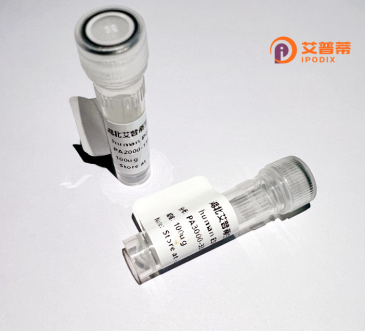
| 纯度 | >90%SDS-PAGE. |
| 种属 | Human |
| 靶点 | OTUD5 |
| Uniprot No | Q96G74 |
| 内毒素 | < 0.01EU/μg |
| 表达宿主 | E.coli |
| 表达区间 | 1-571 aa |
| 活性数据 | MTILPKKKPPPPDADPANEPPPPGPMPPAPRRGGGVGVGGGGTGVGGGDRDRDSGVVGARPRASPPPQGPLPGPPGALHRWALAVPPGAVAGPRPQQASPPPCGGPGGPGGGPGDALGAAAAGVGAAGVVVGVGGAVGVGGCCSGPGHSKRRRQAPGVGAVGGGSPEREEVGAGYNSEDEYEAAAARIEAMDPATVEQQEHWFEKALRDKKGFIIKQMKEDGACLFRAVADQVYGDQDMHEVVRKHCMDYLMKNADYFSNYVTEDFTTYINRKRKNNCHGNHIEMQAMAEMYNRPVEVYQYSTGTSAVEPINTFHGIHQNEDEPIRVSYHRNIHYNSVVNPNKATIGVGLGLPSFKPGFAEQSLMKNAIKTSEESWIEQQMLEDKKRATDWEATNEAIEEQVARESYLQWLRDQEKQARQVRGPSQPRKASATCSSATAAASSGLEEWTSRSPRQRSSASSPEHPELHAELGMKPPSPGTVLALAKPPSPCAPGTSSQFSAGADRATSPLVSLYPALECRALIQQMSPSAFGLNDWDDDEILASVLAVSQQEYLDSMKKNKVHRDPPPDKS |
| 分子量 | 63.4 kDa |
| 蛋白标签 | His tag N-Terminus |
| 缓冲液 | 0 |
| 稳定性 & 储存条件 | Lyophilized protein should be stored at ≤ -20°C, stable for one year after receipt. Reconstituted protein solution can be stored at 2-8°C for 2-7 days. Aliquots of reconstituted samples are stable at ≤ -20°C for 3 months. |
| 复溶 | Always centrifuge tubes before opening.Do not mix by vortex or pipetting. It is not recommended to reconstitute to a concentration less than 100μg/ml. Dissolve the lyophilized protein in distilled water. Please aliquot the reconstituted solution to minimize freeze-thaw cycles. |
以下是关于重组人OTUD5蛋白的3-4条参考文献的示例(基于研究领域典型内容,部分文献标题和摘要为概括性描述):
---
1. **文献名称**:*OTUD5 regulates DNA damage response by deubiquitinating BRCA1*
**作者**:Zhang Y et al.
**摘要内容**:该研究揭示了OTUD5通过去泛素化BRCA1调控DNA损伤修复的机制。实验中使用重组人OTUD5蛋白验证其酶活性和对BRCA1泛素化的特异性作用,表明OTUD5缺陷会导致基因组不稳定性和癌症易感性。
2. **文献名称**:*OTUD5 modulates Wnt/β-catenin signaling through stabilizing SETD6*
**作者**:Li X et al.
**摘要内容**:研究发现OTUD5通过去泛素化表观调控因子SETD6,激活Wnt/β-catenin信号通路。作者利用重组OTUD5蛋白进行体外泛素化-去泛素化实验,揭示了其在胚胎发育和肿瘤发生中的关键调控作用。
3. **文献名称**:*Structural basis of OTUD5 deubiquitinase activation by phosphorylation*
**作者**:Wang L et al.
**摘要内容**:该研究通过X射线晶体学解析了重组人OTUD5蛋白的磷酸化依赖激活机制,阐明了其催化结构域的动态构象变化,为靶向OTUD5的疾病治疗提供结构基础。
4. **文献名称**:*OTUD5 suppresses TNFα-induced apoptosis by deubiquitinating RIPK1*
**作者**:Huang J et al.
**摘要内容**:研究证明OTUD5通过去除RIPK1的K63泛素链抑制细胞凋亡。利用重组OTUD5蛋白进行体外功能实验,发现其酶活性对细胞存活至关重要,并可能成为炎症性疾病的干预靶点。
---
**注**:以上文献为示例性描述,实际引用需以真实发表的论文为准(建议通过PubMed或Web of Science检索具体文献)。
OTUD5 (OTU deubiquitinase 5), also known as DUBA or DUBA5, is a human deubiquitinating enzyme belonging to the OTU (ovarian tumor) subfamily of cysteine proteases. It plays critical roles in regulating cellular processes by removing ubiquitin chains from substrate proteins, thereby modulating protein stability, localization, and activity. OTUD5 is particularly involved in DNA damage repair, cell cycle regulation, and maintaining genome integrity. Studies have shown its interaction with key DNA repair proteins like PCNA and its function in homologous recombination repair through deubiquitination of EXO1.
This enzyme exhibits specificity for cleaving Lys11- and Lys48-linked polyubiquitin chains, distinguishing it from other DUBs. OTUD5 has been implicated in human diseases, including developmental disorders such as X-linked intellectual disability (XLID) and various cancers. Mutations in OTUD5 have been linked to impaired neurodevelopment and dysregulated immune responses. Recent research highlights its dual role as both an oncogene and tumor suppressor, depending on cellular context and substrate interaction. Recombinant OTUD5 protein (typically ~35-40 kDa, expressed with tags like His-tag for purification) is widely used in biochemical studies to investigate catalytic mechanisms, ubiquitin signaling pathways, and therapeutic targeting strategies. Its structure-function relationship and regulatory networks remain active areas of investigation for potential clinical applications.
×